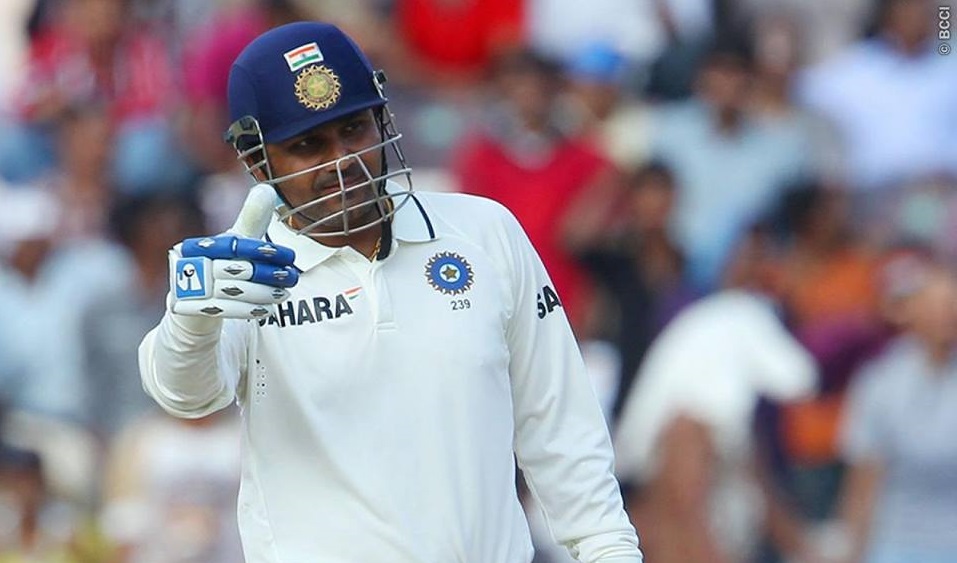Virender Sehwag, the Un-Opener
Test match openers were expected to possess copybook technique. They were to leave more deliveries than they played at. They were supposed to play in the V. And then Virender Sehwag came along.

The ‘Nawab of Najafgarh’ did not possess a conventional technique: he pretty much played at everything. If he had a V, it ranged from point to square-leg. He wasn’t expected to succeed at the Test level. He definitely was not supposed to retire as one of the greats of the game. But he did.
No batsman in the last decade has scored as quickly as him in Test cricket and yet been so prolific. Over his 12-year career in the game’s longest format, Sehwag scored almost at the rate at which Shahid Afridi did, and at an average greater than Kevin Pietersen’s. And he did that opening the innings against the new ball!
The usual metric for greatness is when you compare how better or worse one is compared to the last person who achieved similar feats. It might well be the reason why we do not acknowledge his greatness freely enough – that there has not been a parallel in the history of this sport.
When great batsmen have weaknesses, they learn to overcome them. When Sehwag saw a weakness in his technique, he simply turned it into an absolute strength. When just about everyone with a coaching manual was crying hoarse that Sehwag did not have the footwork to play on the front foot, he was busy getting beside the line of the ball and playing some of the fiercest cuts the game has ever seen.
And as former Indian Test captain and noted commentator Ravi Shastri would say – “no half measures” – which meant that on the occasions where he would misread the length or the bounce of the delivery, he gave himself every chance of clearing the slip cordon.
Sehwag possessed a frighteningly simple outlook to the game. The last fifteen minutes of a Test match session would immediately bring the shell out for many a Test batsman. For Sehwag, though, it was an opportunity to catch tired bowlers off guard and milk 20 runs.
Similarly refreshing was his attitude to milestones. He would invariably try to reach them with big hits. While it brought upon his downfall on the odd occasion (like the 195 at MCG), it showed the power of an uncluttered mind. Earlier in that year, in the final of the 2003 World Cup, India were chasing a mammoth 360. India lost three quick wickets, including Tendulkar, but there was Sehwag – blasting away in his unique zero-risk belligerence. No bowler looked close to taking his wicket. He was run out for 82. It was as good an innings as Mahendra Dhoni’s epic 91 eight years later. But then, who remembers knocks played in lost causes.
One of his absolutely finest efforts came at Galle, against the slightly-fading skills of spin wizard Muttiah Muralitharan. A double hundred, when all around him floundered, to set up a terrific win. He toyed with an attack which was dictating terms to the rest of his mates on a difficult pitch. That innings was a masterclass on how to bat on turning pitches.
Sehwag would set up many such victories for India. He had a penchant to score big hundreds. He is India’s only Test triple centurion, and one among only a handful of global batsmen to have scored two Test triple centuries and four other double centuries. He came close to recording a third triple ton when he scored 293 against Sri Lanka in Mumbai in 2009. Fourteen of his hundreds were scores of over 150.
But numbers just tell half the story. What was more telling was the impact he had on oppositions. Rival attacks were genuinely scared of what he could do. Even the most aggressive captains would bat that extra bit longer to ensure that the target they set can withstand a Sehwag blitz. In the fourth innings of Tests, the Sehwag threat materialised very rarely though, none more striking than in the emotional victory against England, chasing an improbable 387 set up by a rollicking Sehwag special and a Tendulkar ton.
Watching Sehwag was always a joyous experience. He started off as a bowler who could bat. He gained a fair bit of reputation as a Tendulkar clone and then grew out of that image to stake a claim to greatness on his own accord. His batting was simple yet breathtaking. He redefined the perception of risk taking – what was risk for his teammates was not risk for him and that is what made watching him such a wonderful experience. Even when as a cricket follower one super busy, you always found time for Sehwag. His innings would always be conveniently short or delightfully long.
Sehwag’s contributions at the top of the order propelled India on a golden run in Test cricket in the last decade. He was a run machine. He was also the lazy runner who could be run out wandering out of his crease or jogging into it.
In a world of sophistication which strove for perfection, he retained his rough edges. In a world of dour diplomacy, he spoke his heart at press conferences. And in a world which plays the forward defensive to a ball on off stump, he played the cut. The last remaining link to India’s incredible batting formation of the last decade is officially gone.
While it was coming for a while now, it still gives one a twitch. Lucky Mysuru got the opportunity to watch a Sehwag ton for Haryana on Thursday. This is his final domestic season. Let’s cherish it.
Goodbye Sehwag, one of India’s greatest, and one who did it his way.
by,
Srikarun Dhurjati

Comments
Sign up or log in to your account to leave comments and reactions
0 Comments